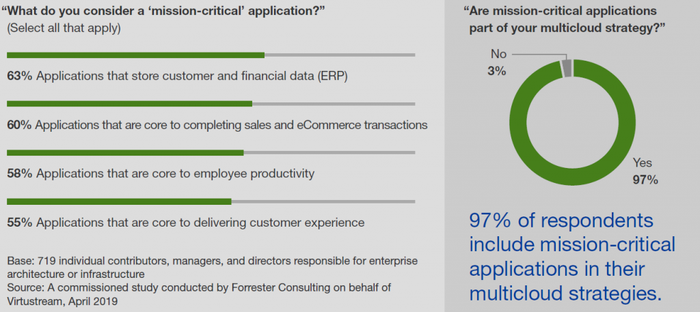Dell/Virtustream: Enterprises Pushing Mission-Critical Workloads to the CloudDell/Virtustream: Enterprises Pushing Mission-Critical Workloads to the Cloud
Virtustream's CEO points to a Forrester report showing most orgs use multicloud for important applications.
May 16, 2019

In the early days of cloud, enterprises were comfortable migrating some of their applications, but they kept mission-critical workloads and sensitive data on-premises and behind the firewall, concerned about such issues as security, privacy, control and compliance.
That’s changing, however, with the ongoing maturation of cloud computing and the rising adoption of hybrid cloud and multicloud strategies by enterprises, according to a study conducted by Forrester Research analysts.
 The report, Multicloud Strategies Drive Mission-Critical Benefits, commissioned by Virtustream, a cloud company owned by Dell Technologies, found using multiple cloud providers gives organizations the options and flexibility they need to find the right environments for their mission-critical applications, even if that means adding more complexity to the picture. The survey found that almost all (97 percent) of the 719 respondents said that migrating mission-critical applications was part of their multicloud strategies.
The report, Multicloud Strategies Drive Mission-Critical Benefits, commissioned by Virtustream, a cloud company owned by Dell Technologies, found using multiple cloud providers gives organizations the options and flexibility they need to find the right environments for their mission-critical applications, even if that means adding more complexity to the picture. The survey found that almost all (97 percent) of the 719 respondents said that migrating mission-critical applications was part of their multicloud strategies.
“Simply put, enterprises leverage multiple cloud platforms to meet their cloud architectural requirements,” the Forrester analysts wrote in the report. “Not only does this study reinforce this, but it also overwhelmingly shows that enterprise multicloud strategies include organizations’ mission-critical applications worldwide.”
That mirrors what Rory Read is seeing. Read wears a few different hats at Dell, including executive vice president and chief operating executive at Dell and president and CEO of Virtustream, which was founded a decade ago with the idea of hosting enterprises’ most complex and mission-critical workloads in the cloud. The company, which came to Dell when the tech giant bought EMC for more than $60 billion in 2016, now finds that almost 70 percent of its business involves hosting SAP applications for customers.

Dell/Virtustream’s Rory Read
“The issues that customers had in the earlier years, back three or four years ago, they were very concerned about bringing mission-critical apps to the cloud because of the risk,” Read told Channel Futures in an interview during the recent Dell Technologies World show in Las Vegas. “It wasn’t a problem to move development workloads or things like that, but as it worked around mission-critical, they wanted to make sure they had a solution, because if these don’t work, their businesses take fundamental issues.”
Enterprises define “mission critical” a number of ways, according to the Forrester report. The most common are ERP applications that store customer and financial data and those that are critical to completing sale and e-commerce transactions, employee productivity and customer experience. Embracing multicloud strategies fits with what enterprises are looking for when considering migrating these applications.
“Diverse applications require a long list of unique requirements, and leveraging multiple sourcing options can create strategic advantage,” the authors wrote. “Using multiple clouds … allows organizations to optimize across their portfolios. Sometimes, this is for simple use cases, like backup and recovery of data. … But usually, multicloud serves a larger purpose by providing …
… features or functions that serve specific performance characteristics and configurations that translate into massive cost advantages or service-level guarantees offered by different cloud platforms. Sometimes, different departments select different solutions, resulting in a less intentional multicloud strategy.”
Virtustream’s Read said that about 65-70% of his company’s business involves hosting SAP workloads, adding that these business-critical enterprise applications often come with a surrounding ecosystem that can be addressed by a multicloud approach. Among Virtustream’s offerings are Virtustream Enterprise Cloud, a software layer that includes xStream for management, automation and assurance, and cloud managed services.
“Everyone’s planning on having three to five cloud relationships,” the CEO said. “Think about this in a mission-critical application like SAP. SAP is this huge monolithic base application, but what’s around it is 100 or 150 other applications that feed in to create that ecosystem. What we’re finding that we may move that SAP core system to the cloud on Virtustream, for example. Those other applications, some might be on Virtustream, some on [Microsoft] Azure, some on Google [Cloud], some on AWS (Amazon Web Services), some on some private clouds. What they’re looking for with the Virtusream software stack is to begin to be able to manage that ecosystem across clouds.”
What’s driving enterprises to bring more business-critical applications to the cloud is often the same benefits they see with less critical workloads, Read said, adding that “every business is becoming a software business and as they want to take advantage of those technologies, they want to move their historic environments to the cloud, lower that cost, make sure they have the right skills and make the investments in the processes and applications that will allow them to rapidly capture markets, rapidly change technology and capabilities, and take out all the provisioning.”
Several reports have been published this year showing a strong drive by enterprises toward multicloud and hybrid clouds. Respondents to a survey by workload automation vendor Turbonomics found they use an average of two cloud providers to avoid vendor lock-in and have the ability to choose the best services for their applications and data.
As enterprises grow their reliance on the cloud, channel partners also are evolving to adapt to the changes, Read said. Over the past 15 or so years, the focus for many partners has shifted from physical assets to solutions. He pointed to Deloitte and Accenture as examples, and noted that World Wide Technology has created a set of cloud solutions.
“There’s always going to be a need for velocity, moving content and fulfilling and creating reach, but they are adding more and more value-added services and each one has a little different strategy,” Read said. “The successful ones will combine that with the solutions offerings. Those are the partners – whether they’re SIs or VARs or the traditional big partners like a WWT – that have real thought around solutions.”
About the Author
You May Also Like


